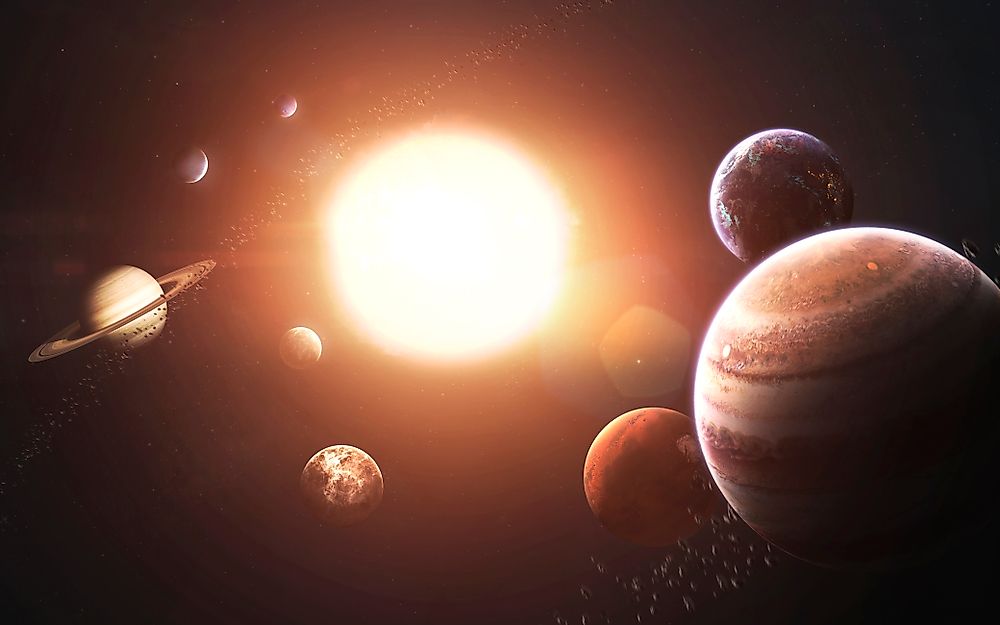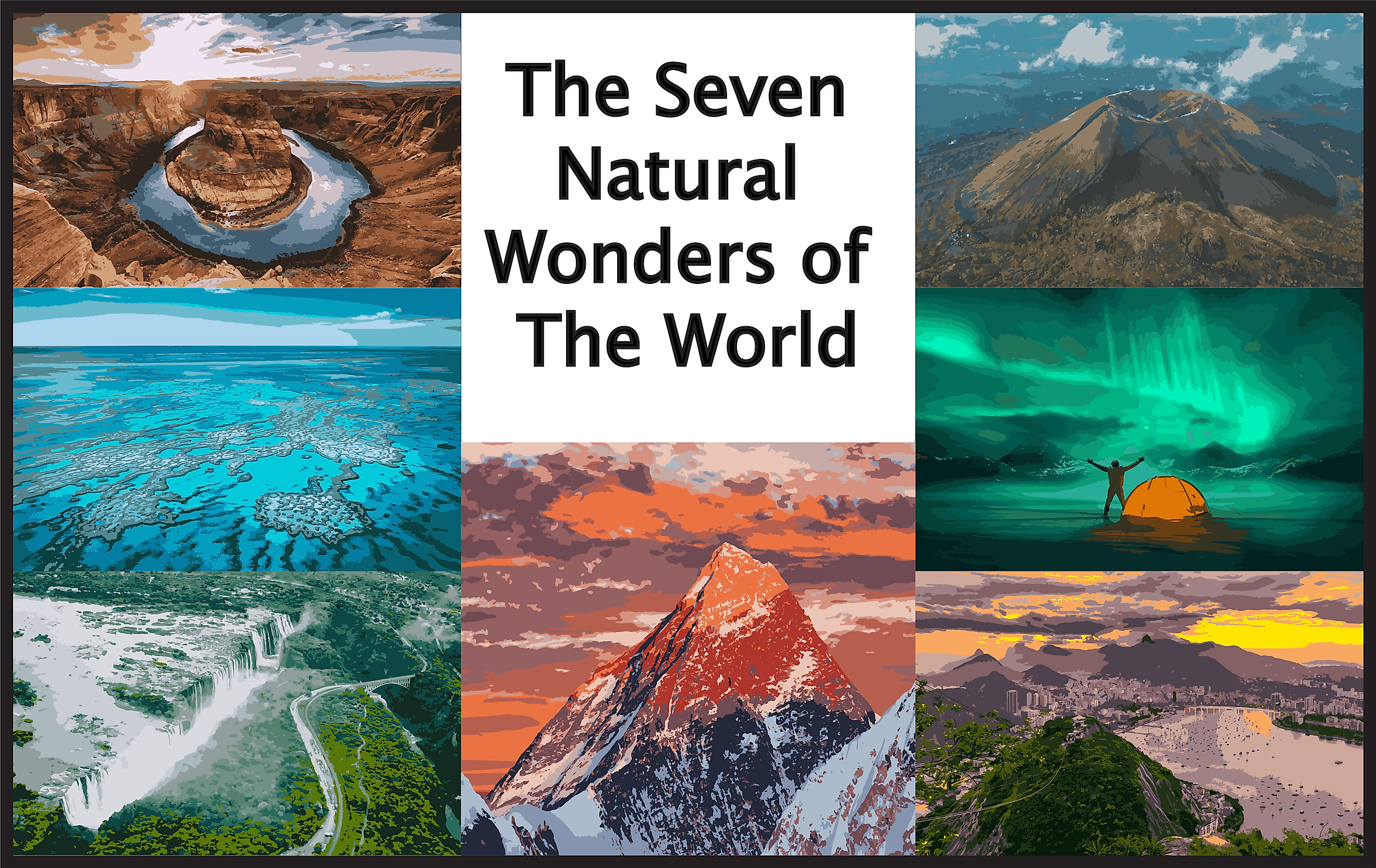
The 7 Natural Wonders Of The World
Although over half the world's population now lives in cities, humankind remains fascinated by nature. Amid the millions of kilometers of nature that span the Earth, certain attractions stand out as particularly breathtaking, drawing thousands, and sometimes millions of visitors each year to appreciate them. An investigative journalist working for CNN conducted a study to identify the world's most incredible wonders, using statistical analysis to support his findings. According to his research, the most awe-inspiring natural wonders include Mount Everest, Paricutin Volcano, The Grand Canyon, Victoria Falls, The Harbor of Rio de Janeiro, the Great Barrier Reef, and the Northern Lights.
The 7 Natural Wonders Of The World
| Natura Wonder | Location |
|---|---|
| Mount Everest | Nepal-China Border |
| Paricutin Volcano | Michoacán, Mexico |
| The Grand Canyon | Arizona, United States |
| Victoria Falls | Zambia-Zimbabwe Border |
| The Harbor Of Rio de Janeiro | Rio de Janeiro, Brazil |
| Great Barrier Reef | Near the coast of Queensland, Australia |
| Northern Lights |
Norway, Sweden, Finland, Iceland, Greenland, Canada, and the U.S. state of Alaska |
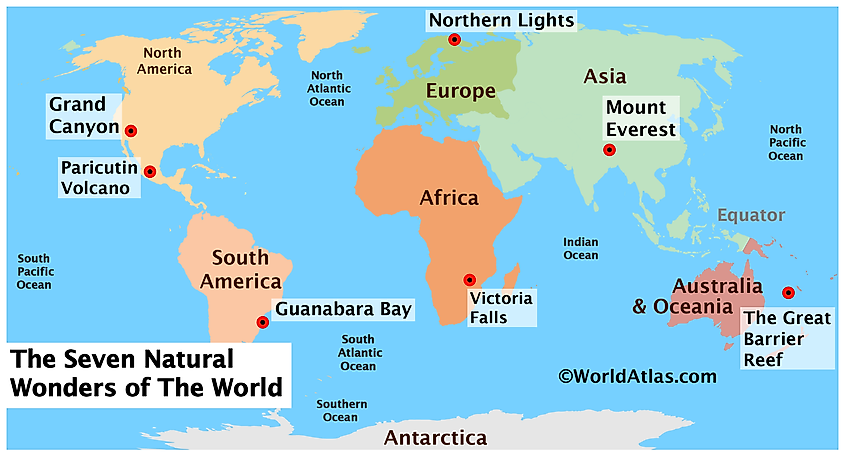
Mount Everest
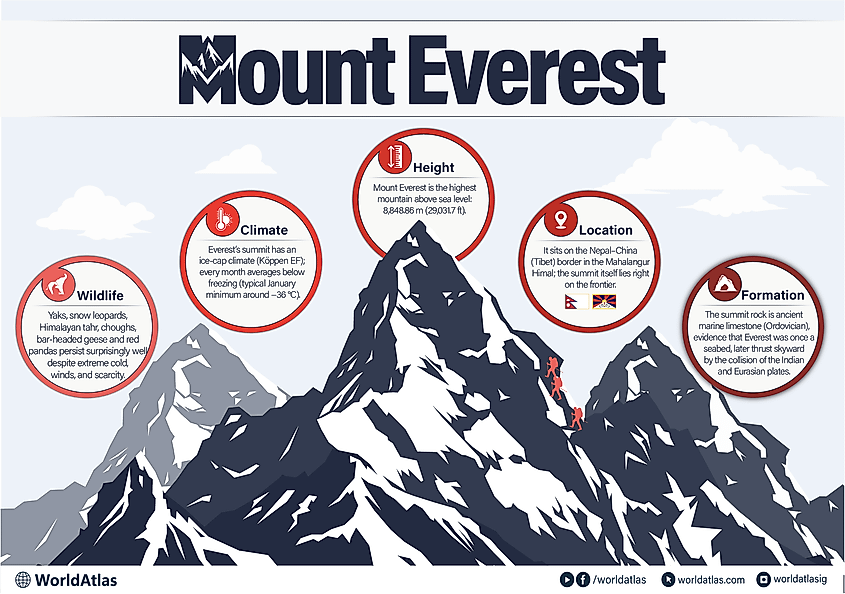
Mount Everest, the highest peak on Earth at 8,848 meters (29,029 feet), is known as a formidable challenge for climbers. It is part of the Himalayan mountain range and straddles the China(Tibetan)-Nepal border, with the summit marking the official boundary. Formed from metamorphic and sedimentary rocks over sixty million years ago, the mountain experiences harsh weather, often below -60°C (-76°F), and is a crucial source for major Asian rivers. It hosts unique wildlife like the snow leopard and Himalayan tahr, adapted to extreme altitudes. While Everest's height is surpassed by Mauna Kea's underwater portion, its peak remains the tallest above sea level.
The number of hikers reaching Mount Everest's summit has exponentially increased over the past few decades. In 1990, fewer than 100 people made the ascent, a minuscule number compared to today's count. In 2023, around 656 people reached the summit, though this is still less than the pre-pandemic peak of nearly 900 climbers in 2019. Local Sherpa communities, who work as guides, heavily rely on mountaineering tourism. However, there is ongoing debate about the ethics of exposing them to danger, especially with increasing tourism numbers and climate change-related disasters. Litter from tourists and microplastic pollution further exacerbate environmental concerns around Everest, leading to many activists questioning the number of hikers allowed to ascend the mountain.
Paricutin Volcano

The Parícutin Volcano in Michoacán, Mexico, is one of the youngest volcanos on the planet. Triggered by a series of earthquakes, it erupted in a farmer's cornfield, bursting with molten lava, forming a cinder cone shape and rapidly reaching a height of 424 meters (1,391 feet). During its lengthy eruption that lasted from 1943 through 1952, Parícutin released extensive lava flows and ash, covering approximately 25 square kilometers (9.7 square miles) and necessitating the evacuation of neighboring villages. Notably, the eruption affected the village of San Juan Parangaricutiro, with its church steeple now protruding from solidified lava. In its current dormant state, Parícutin presents a fascinating landscape of hardened lava and ash, drawing both tourists and geologists. Visitors can climb the peak and explore the area, which includes the striking sight of the encased ruins of the San Juan Parangaricutiro Church.
Although the volcanic landscape is not particularly hospitable for life, certain species have adapted to the ecosystem. Birds of prey such as eagles and hawks often sore above the volcano, and roadrunners and quails live among the scattered vegetation. Bats are also an essential element in the ecosystem, controlling the insect population. Some animals live within the crevices of the volcanic rock as well, such as snakes, pack rats, and shrews.
The Grand Canyon
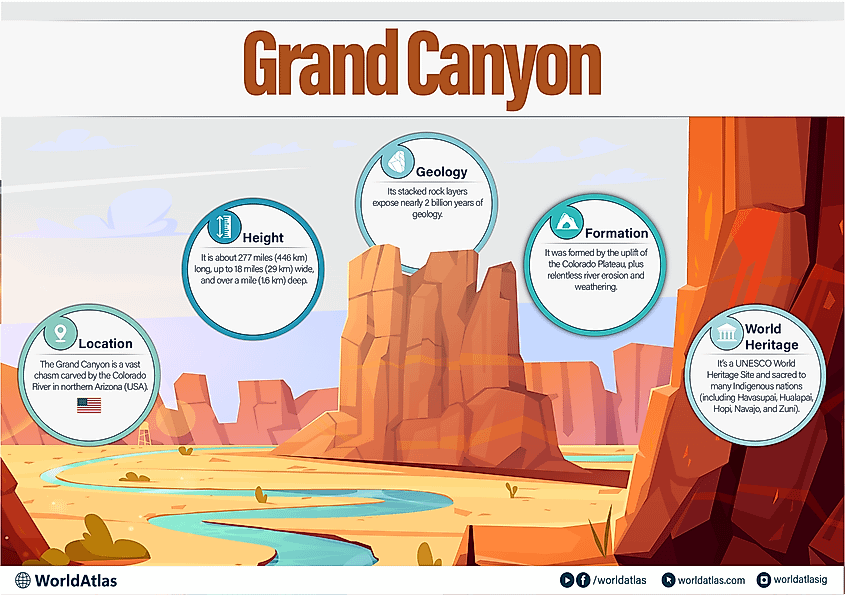
The Grand Canyon in Arizona reveals 1.2 billion years of Earth's history through its extensive rock layers, shaped by the Colorado River over billions of years. Spanning 447 kilometers (277 miles) in length, with widths up to 29 kilometers (18 miles) and depths of over 1.8 kilometers (1.1 miles), it is one of the world's largest canyons. To put this depth in perspective, the Empire State Building could be stacked in the Grand Canyon over four times. The canyon's rust-red colors and sediment layers stretch endlessly, while its diverse wildlife includes 1,500 plant species, 355 birds, 89 mammals, 47 reptiles, 9 amphibians, and 17 fish. The canyon is also home to a unique species: the Grand Canyon Pink Rattlesnake, which has a pink hue to blend into the colorful rocks.
Today, around six million people visit Grand Canyon National Park annually. The national park is 4,931 square kilometers (1,904 square miles), making it larger than the US state of Rhode Island. Visitors enjoy its grandeur through sightseeing, hiking, and rafting, making it a must-see on any U.S. road trip.
Victoria Falls

Victoria Falls, straddling Zambia and Zimbabwe, is the world’s largest waterfall, stretching 1,708 meters (5,604 feet) wide and plunging 108 meters (354 feet). During the wet season, about 500 million liters of water flow over the edge each minute, creating the largest continuous sheet of falling water on Earth. Formed by the Zambezi River and basalt erosion, the falls, known as Mosi-oa-Tunya or "The Smoke That Thunders," average 1,088 cubic meters per second in water flow. Because of its strong power, the falls can sometimes even be heard up to 40 kilometers (25 miles) away.
Over one million tourists flock to the Falls each year, partaking in a range of experiences: viewing the falls from multiple vantage points, swimming close to the fall's edge in the low season, and even bungee jumping off the Victoria Falls Bridge. Both Zambia and Zimbabwe have national parks on the falls and UNESCO declared it a World Heritage Site in 1989.
The Harbor Of Rio de Janeiro
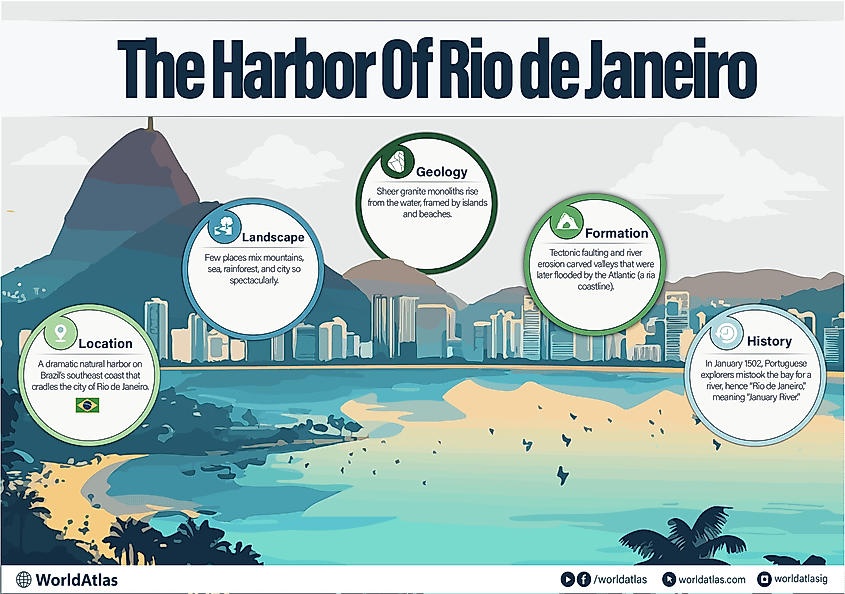
The Harbor of Rio de Janeiro, or Guanabara Bay, in southeastern Brazil, is the world's largest natural bay by volume. The bay, covering 412 square kilometers with depths of up to 17 meters (56 feet), contains notable landmarks such as Sugarloaf Mountain and Morro Cara de Cão. Its entrance, framed by granite rock formations and monoliths, creates an impressive visual landscape that draws in millions of tourists each year. In addition to its natural scenery, the bay also holds special historical significance, having hosted events such as the initial arrival of the Portuguese colonists in 1502. The city also considers it an important symbol, representing its cultural vibrancy, energy, and maritime heritage.
Despite the harbor's evolution into a major economic and human activity hub, featuring key locations in the city and popular beaches such as Copacabana, the bay's natural beauty endures. The way that city life has harmoniously blended with the bay's natural elements remains something of a conundrum. Although Guanabara Bay hosts one of the busiest ports in Brazil, it continues to be rich in biodiversity and wildlife, home to species such as dolphin pods, green sea turtles, jellyfish, tropical sea fish, Capuchin monkeys, hermit crabs, seahorses, great egrets, and more.
Great Barrier Reef
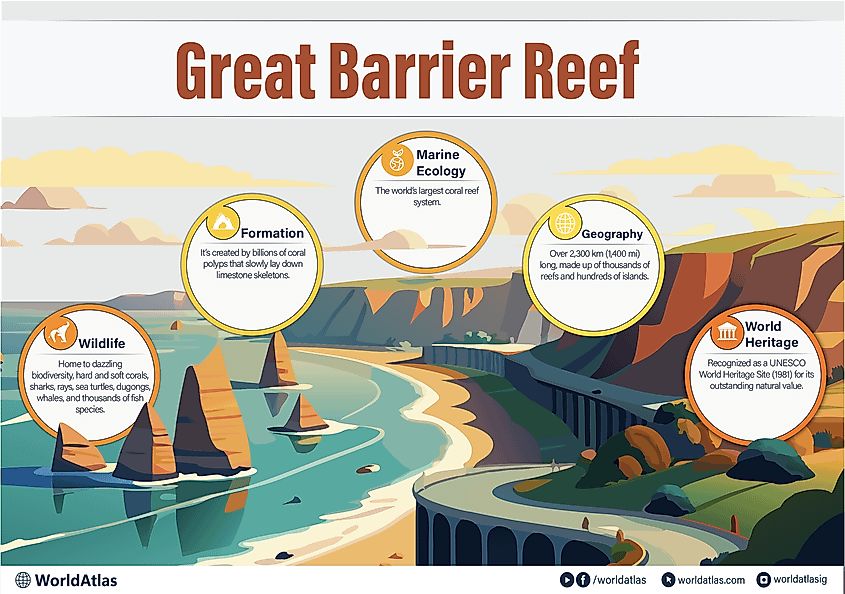
The Great Barrier Reef, off Queensland, Australia in the Coral Sea, is the world's largest coral reef system, stretching over 2,300 kilometers with 2,900 reefs and 900 islands across 344,400 square kilometers. Known for its biodiversity, it houses over 1,500 fish species, 411 types of hard coral, and a third of the world's soft corals. The reef also supports 134 shark and ray species, six of seven threatened marine turtle species, and over 30 marine mammals, serving as a critical breeding ground for humpback whales and a sanctuary for endangered species like the dugong and green turtle.
Despite threats from tourism and climate change, the reef remains a major natural wonder, attracting over 2 million visitors each year, many partaking in recreational activities such as diving, snorkeling, helicopter tours, glass-bottom boat tours, or sailing. Conservation groups are actively working to protect the reef through actions such as addressing climate change, removing invasive species like the crown-of-thorns starfish, and reducing water pollution in the area.
Northern Lights

The Northern Lights, or Aurora Borealis, are a stunning natural phenomenon seen mostly in polar regions, including the Arctic Circle. This light display showcases dynamic colors—greens, blues, and purples—created when particles from the sun, traveling at speeds up to 72 million kilometers per hour (45 million miles per hour), collide with the Earth's atmospheric gases. The intensity and form vary with solar activity and Earth's magnetic field, often being most vivid during dark winter nights and near equinoxes. These moving colors result from electrically charged particles from solar flares interacting with Earth's atmosphere, producing a mesmerizing effect.
Prime viewing locations are away from city lights, with the best sights in places like Norway, Sweden, Finland, Iceland, Greenland, Canada, and the U.S. state of Alaska. Winter tourism in these northern countries often spikes due to visitors hoping to witness this light phenomenon. With a bit of luck, patience, and a warm jacket, you too might one day witness this breathtaking event!
Final Thoughts
Crashing waterfalls, soaring heights, and atmospheric phenomena — our home planet knows how to keep a crowd's attention. These features are not simply geographic; they often interweave with the miracle of biological life found nowhere else in the Universe. Victoria Falls, for instance, is twice the experience thanks to greenery and exotic creatures flying and swimming through its misty waters. As far as natural wonders go, auroral activity may be present on other planets that have magnetic fields and an atmosphere. Still, those barren rocks lack observers like you and me, and humanity is yet another wonder of our world.


